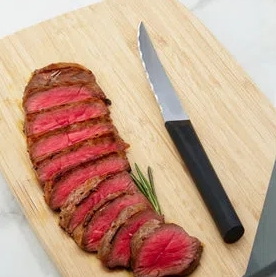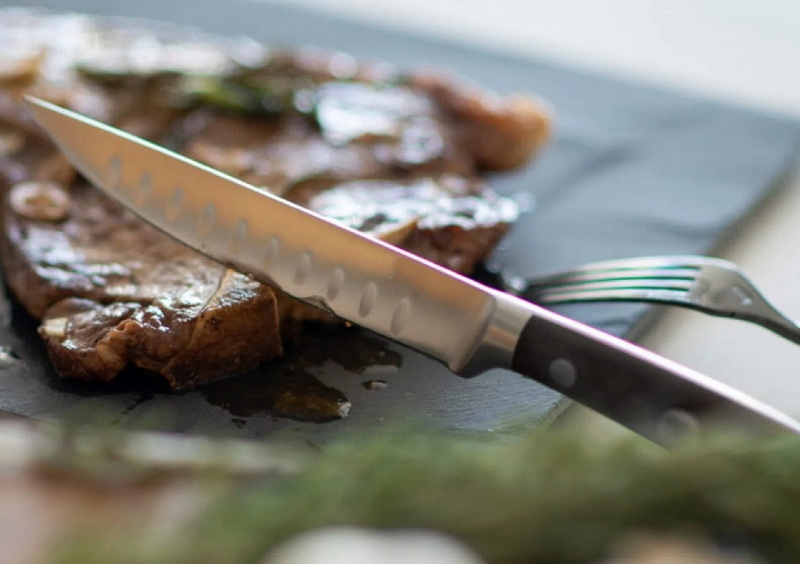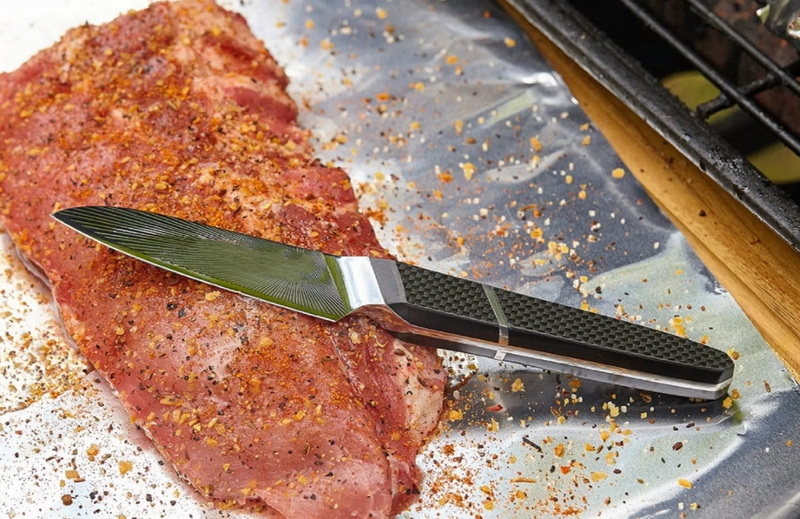

Views: 800 Author: sales@insightknife.com.cn Publish Time: 2025-01-07 Origin: Site








Content Menu
● Understanding Serrated Knives
>> Why Sharpen Serrated Knives?
● Step-by-Step Guide to Sharpening Serrated Steak Knives
>> Sharpening with a Ceramic Rod
>> Sharpening with a Tapered Round File
>> Using an Electric Knife Sharpener
● Maintaining Your Serrated Knives
● Frequently Asked Questions regarding Sharpen Serrated Steak Knives
>> 1. How often should I sharpen my serrated steak knives?
>> 2. Can I use a regular knife sharpener for serrated knives?
>> 3. What is the best way to test if my serrated knife is sharp?
>> 4. Is it necessary to sharpen both sides of a serrated knife?
>> 5. What should I do if my serrated knife has nicks or chips?
Serrated steak knives are essential tools in any kitchen, known for their ability to slice through meat with ease. However, over time, these knives can become dull, making them less effective. Sharpening serrated steak knives requires a different approach than sharpening straight-edged knives. This article will guide you through the process of sharpening serrated steak knives, ensuring they remain sharp and functional.
Serrated knives feature a blade with a series of small, jagged teeth along the edge. This design allows them to grip and cut through tough surfaces, such as the crust of bread or the fibers of meat. The unique shape of the blade means that traditional sharpening methods may not be effective. The serrations create a sawing action that helps to slice through food without crushing it, making these knives particularly useful for cutting through tougher cuts of meat or crusty bread. Understanding the mechanics of how these knives work can help you appreciate their design and the importance of keeping them sharp.
Maintaining the sharpness of your serrated knives is crucial for several reasons. A sharp knife not only makes cutting easier but also enhances safety in the kitchen. Dull knives require more force to cut, increasing the risk of slips and accidents. Additionally, a sharp knife produces cleaner cuts, which is particularly important for presentation when serving food. When a knife is sharp, it glides through food with minimal effort, preserving the texture and appearance of the dish. This is especially important in culinary settings where presentation is key, such as in fine dining or when hosting guests.
A ceramic sharpening rod is one of the best tools for sharpening serrated knives. Its hardness allows it to effectively hone the edges of the serrations without damaging the blade. Ceramic rods are durable and can maintain their shape over time, making them a reliable choice for regular maintenance. They are also less likely to cause damage to the knife compared to metal sharpeners, which can be too aggressive for serrated edges. Using a ceramic rod can help you achieve a fine edge on your serrated knife, ensuring it performs optimally.
A tapered round file is another excellent option for sharpening serrated knives. This tool can fit into the grooves of the serrated edge, allowing for precise sharpening of each tooth. The tapered design means that it can reach into the deepest parts of the serrations, ensuring that every tooth is sharpened evenly. This method is particularly effective for knives with deeper serrations, where a ceramic rod may not reach effectively. Using a tapered round file requires a steady hand and attention to detail, but it can yield excellent results when done correctly.
Some electric knife sharpeners come with a slot specifically designed for serrated knives. While these can be convenient, it is essential to check the manufacturer's recommendations, as not all serrated knives are suitable for electric sharpening. Electric sharpeners can save time and effort, especially for those who may not feel comfortable sharpening knives by hand. However, they can sometimes remove more material than necessary, which can shorten the lifespan of the knife. It’s important to use these devices judiciously and to follow the instructions carefully to avoid damaging your knives.

Before you begin sharpening, ensure you have a clean, flat surface to work on. Gather your sharpening tools, a towel for cleaning, and a light source to help you see the blade clearly. A well-lit workspace is crucial, as it allows you to inspect the blade closely and ensure that you are sharpening at the correct angle. Additionally, having a non-slip mat or surface can help keep your knife steady while you work, reducing the risk of accidents.
Examine the serrated knife to identify which side needs sharpening. Typically, only one side of a serrated knife is sharpened, while the other side remains flat. This design helps maintain the knife's cutting efficiency. Look for signs of wear, such as dullness or nicks in the blade. Understanding the condition of your knife will help you determine the best approach for sharpening. If the knife has significant damage, it may require more extensive work or professional sharpening.
Position the Knife: Hold the knife securely in one hand, ensuring the serrated edge is facing up. A firm grip is essential to maintain control while sharpening.
Angle the Rod: Place the ceramic rod at the same angle as the bevel of the serrated edge. This angle is usually around 20 degrees. Maintaining the correct angle is crucial for effective sharpening.
Sharpen Each Serration: Gently insert the rod into each serration and pull it towards you. Repeat this process for each tooth, applying light pressure to avoid damaging the blade. Focus on one serration at a time to ensure thorough sharpening.
Check for Sharpness: After sharpening, test the knife on a piece of paper or a tomato. A sharp knife should cut cleanly without tearing. If the knife does not perform as expected, repeat the sharpening process until you achieve the desired sharpness.
Hold the Knife: Secure the knife in one hand, ensuring the serrated edge is accessible. A stable position will help you apply consistent pressure while filing.
Insert the File: Place the tapered round file into the first serration, matching the angle of the bevel. Ensure that the file fits snugly within the serration for effective sharpening.
File the Edge: Gently push the file forward, applying light pressure. Repeat this for each serration, ensuring you maintain the same angle throughout. Take your time to avoid over-filing any single serration.
Clean the Blade: Wipe the blade with a towel to remove any metal shavings or debris. This step is important to prevent any residue from affecting the knife's performance during use.

Read the Instructions: Before using an electric sharpener, read the manufacturer's instructions to ensure it is suitable for serrated knives. Familiarizing yourself with the device will help you use it effectively.
Insert the Knife: Place the knife in the designated slot, ensuring it is aligned correctly. Proper alignment is key to achieving an even sharpened edge.
Activate the Sharpener: Turn on the sharpener and allow it to do the work. Avoid forcing the knife through the sharpener, as this can damage the blade. Let the machine do the work, and monitor the process to ensure it is sharpening evenly.
Test the Sharpness: After sharpening, test the knife to ensure it has regained its cutting ability. If necessary, repeat the sharpening process or touch up the edge with a ceramic rod for finer results.
After each use, clean your serrated knives with warm, soapy water and a soft sponge. Avoid using abrasive materials that can scratch the blade. Dry the knife thoroughly to prevent rusting. Regular cleaning not only keeps the knife looking good but also prevents food particles from building up in the serrations, which can lead to bacteria growth. Proper hygiene is essential in the kitchen, especially when handling raw meats.
Store your serrated knives in a knife block or on a magnetic strip to protect the blades. Avoid tossing them into a drawer, as this can dull the edges and cause damage. Proper storage helps maintain the sharpness of the blade and prevents accidental cuts when reaching for other utensils. Consider using blade guards for additional protection if you store your knives in a drawer.
Regularly check the sharpness of your serrated knives. Depending on usage, you may need to sharpen them every few months. Keeping them sharp will enhance their performance and longevity. Developing a routine for checking and sharpening your knives can help you stay on top of maintenance, ensuring that your knives are always ready for use. Additionally, consider keeping a sharpening schedule based on your cooking habits to ensure your knives remain in optimal condition.
Sharpening serrated steak knives may seem daunting, but with the right tools and techniques, it can be a straightforward process. Whether you choose to use a ceramic rod, a tapered round file, or an electric sharpener, maintaining the sharpness of your knives is essential for effective and safe cutting. By following the steps outlined in this guide, you can ensure your serrated steak knives remain in top condition, ready to tackle any meal with ease. Investing time in the care and maintenance of your knives not only enhances your cooking experience but also prolongs the life of these essential kitchen tools.

It is recommended to sharpen serrated steak knives every few months, depending on usage. If you notice that the knife is tearing rather than slicing through food, it’s time to sharpen it.
No, regular knife sharpeners are not designed for serrated knives. It is best to use a ceramic rod, a tapered round file, or an electric sharpener specifically designed for serrated edges to avoid damaging the blade.
A simple way to test the sharpness of a serrated knife is to slice through a piece of ripe tomato or a sheet of paper. A sharp knife should cut cleanly without tearing or crushing the material.
No, typically only one side of a serrated knife is sharpened. The other side remains flat to maintain the knife's cutting efficiency and design.
If your serrated knife has nicks or chips, it may require more extensive sharpening. You can use a tapered round file to carefully file down the damaged areas, or consider taking it to a professional knife sharpener for repair.